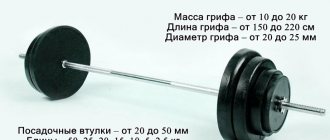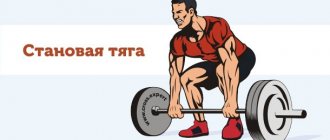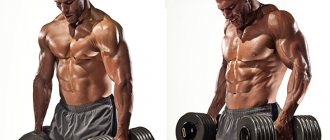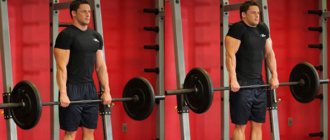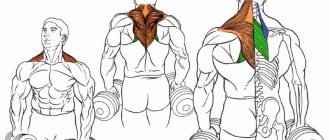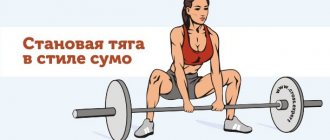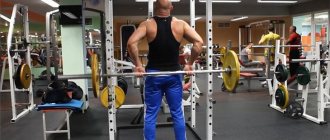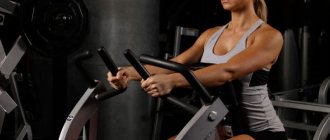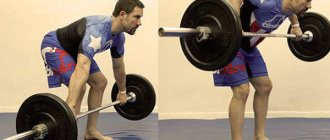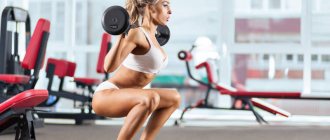This exercise is rarely used, and not many people know about it.
It is not the most popular, but I still want to talk about it, because perhaps this is exactly what you need. Here I talked about deadlifts. This exercise has many variations and each of them has its own advantages. Today I’ll tell you about deadlifts on straight legs.
This is a rather controversial exercise, in my opinion. No, not because it is ineffective, but because its effectiveness does not justify its technical complexity and risk of injury.
But nevertheless, many people do it and are very happy with it . And many people confuse the straight-legged deadlift with the Romanian (dead) deadlift, and I’ll tell you how they differ.
Before you start practicing
Before you start practicing this particular deadlift, you need to thoroughly study the technique of doing it. Deadlifts on straight legs do not tolerate inaccuracies in execution and frivolity in terms of selecting weights.
Therefore, before starting training, you need to sufficiently master the classic deadlift technique and achieve certain results in it.
Whatever the traction, it always requires special attention to fixing the back in a straight position. And it is this exercise that requires special attention and approach, since the angle between the torso and legs (that is, the ratio) is too large.
Alexander Shestov
TRX Certified Trainer
Ask a Question
If an athlete has had or has even minor back problems, before starting training, you should consult a doctor about the advisability and safety of such exercises for your own body.
It should be remembered that the deadlift on straight legs is based, first of all, on good stretching. If there is none, then such activities will be premature and even dangerous to your own health.
If an athlete, for example, is unable to touch the floor with his palms while standing on straight legs, then this will be the first point of a kind of unsuccessful stretching test. Without stretched Achilles tendons, nothing good will come of this venture.
To prevent this from happening, you need to prepare yourself properly by stretching for at least several weeks.
When training to improve stretching, you should not do deadlifts at the same time! And if you do do it, then only with minimal weights and only from an elevation.
The anatomical features of a particular athlete are also very important. In some cases, even with an ideal stretch, it is impossible to perform a deadlift without allowing the back to arch. Such cases require measures to reduce the amplitude of movements, that is, the initial height of the bar must be increased by any available means and methods.
The amplitude should be such that the back always remains straight, regardless of the phase of the movement.
Varieties
1) The movement can be performed with full amplitude or incomplete. The full range of motion is only suitable for experienced athletes, while a beginner should place the barbell on a bench or other elevated platform.
2) The grip is adjustable depending on the anatomical features, but in the deadlift you should not use a grip that is too wide.
3) The barbell can be grasped with a direct grip or a mixed grip.
4) Deadlifts can be performed not only with a regular barbell, but also with a trap bar. It is made specifically for deadlifts and their variations. The trap bar has a more comfortable grip and allows you to more accurately track the trajectory of movement when performing the exercise.
Correct technique is the key to success and safety of training
Correct technique:
- The starting position is that the legs are not very wide apart, but the feet are parallel to each other.
- The grip width is chosen slightly larger than the width of your own pelvis.
- The feet are positioned under the barbell so that the shins touch it.
- The pelvic part is retracted back to the maximum, while the back remains straight and the shoulder blades are brought together.
- You need to bend your knees slightly to relieve tension from them, but you absolutely cannot bend your knee joints inward.
- The barbell must be lifted smoothly, without jerking or sudden movements. Look straight ahead.
- The weight is placed near the shins, and when the upper phase is reached, the body must be fixed in a strictly straight position, and the knees must be straightened. It is not permissible to tilt the body back to avoid overloading the lumbar region.
- The barbell should be lowered while simultaneously tilting the body forward and bending the knees. Everything is done in the reverse order with the same precision as when lifting.
You need to ensure proper breathing - this is a very important aspect. Exhalation occurs during the hardest part of the exercise, that is, during the ascent, and when the projectile moves down, the breath is held, while inhalation is performed in the upper phase of the exercise.
What muscles work
The exercise is not intended to improve your ability to lift weights. Compared to the classic deadlift, smaller weights are used to work the target muscle groups with minimal risk of injury. Athletes and coaches plan a smaller load and volume of training, focusing on the actions of the desired muscles.
When performing deadlifts:
- predominantly work the buttocks, back extensors and the back of the thigh: biceps, semitendinosus and semimembranosus muscles;
- the muscles of the front surface of the legs are practically not involved, because the knee joints bend slightly;
- straight body position develops dynamic flexibility, especially in the hips and lower back;
- the forearm flexors, which are responsible for grip strength, are strengthened.
Lifting occurs due to contraction of the posterior chain muscles, which return the body to an upright position. The movement involves the hip, knee, scapulothoracic joints, intervertebral segments of the spine (lumbar and thoracic region), and wrists. When the movement is performed correctly, only the hip joint bends and extends; deep stabilizer muscles control the position of the spine.
Tips to the point
No matter what this exercise is called - straight-legged deadlift - there is still minimal bending of the knees in it. Much smaller than in the classics, and even smaller than in the Romanian draft. It is needed to keep the lumbar region straight in the lower phase of the exercise.
The weights need to be selected significantly less than in the classics and the same Romanian deadlift. As a basis, you should take a weight bar that is half the athlete’s own weight (approximately). It must be added in the future with great caution, as training progresses - as a rule, this weight is added by no more than 3 kg. in Week. All this is individual, of course.
Control over the retraction of the shoulder blades should be constant - you can even ask your colleagues in the workshop to keep an eye on this important indicator for the first time and make a timely remark about this.
If this action is still not performed with the required precision, then the risk of injury increases. To avoid this you need to reduce the working weight. All this is done in order to keep the straightness of the back under control.
We should not forget that the load should fall on the heels, as well as the center of gravity.
In the deadlift, a large number of repetitions are practiced - up to about 15, and the exercise itself is not done to the point of exhaustion, so as not to lose control of the correct technique.
The athlete’s pelvic part is used as a “pusher”; it is this part that gives the necessary push in the lower phase of the exercise.
The use of straps is not recommended, since there is no work with near-maximum weights, and this means that there is not a huge load on the wrists, and the existing one will only strengthen them. This will not work if you use straps.
The exercise should not be done too often - deadlifts should be performed weekly enough.
To avoid mistakes
The most common execution errors:
- Back arch in the lower back and thoracic region.
- Concentration of effort in the back (the desire to lift the weight with the back muscles), and not in the legs and pelvis.
- Neglecting stretching.
- Lifting the barbell away from the legs during movement.
- The desire to straighten the knees to the detriment of technique.
- Shifting the center of gravity from the heels to the toes.
Training for girls and women
Due to the complexity of the exercise itself and the fear of injury, representatives of the fair sex often do not want to perform it. However, not every man does it, considering it boring.
However, deadlifting is not only suitable, but also encouraged for girls and women. And, after the trainer reminds them that this type of deadlift develops the gluteal muscles, as well as the back of the thighs, and generally gives a feminine silhouette, the women eventually agree to perform it, convinced by such compelling arguments.
Girls need to do deadlifts with a minimum amplitude, especially at first.
As for such an important aspect as the execution technique, it practically does not differ from the technique followed by male athletes, with the exception of the above clarification.
Recommendations
Below are some tips to help you perform the exercise with perfect technique and reap the benefits.
- Do not allow the barbell to move away from your body during the lifting phase.
- You can start the exercise either from the floor or by removing the barbell from the power rack rack.
- Keep your knees slightly bent and make sure the movement comes primarily from your hips. The spine should not move or bend.
- The position of the neck is very individual. Some prefer a neutral position, while others direct their gaze slightly upward. Try the exercise with different variations and see which one works best for your individual anatomy and biomechanics.
- Don't worry about retracting your shoulder blades, it won't help your deadlift.
- Make sure you wrap your thumbs around the bar. Squeeze it as tightly as possible, as if you want to leave an imprint on it.
- As you lift the barbell, you will naturally notice the weight shifting to your heels. Try to distribute the load across your entire foot.
- Make sure your elbows are locked, that they are in a neutral position and not too bent.
Single leg deadlift with dumbbells
One cannot ignore another type of deadlift, like the single-leg deadlift with dumbbells. Looking ahead, it should be noted that its benefits are obvious.
This exercise is unusual, rather original, and many have not even heard anything about it, let alone performed it. Its advantages:
- More precise, accentuated work on both the thigh biceps and buttocks and their excellent correction.
- The muscles in these areas become “drier”.
- Improving coordination of movements, vestibular apparatus and plasticity of the athlete.
- Stabilization of the knee joints.
- A significant “blow” to the asymmetry of the gluteal muscles.
- An excellent training opportunity for those people who have back problems. In addition, the exercise partly replaces squats with weights and various leg presses - this is very important for those for whom these exercises are contraindicated.
How to perform and technical details:
- Dumbbells in furry hands near the hips. The starting position is a straight stance with the right leg slightly moved back.
- You need to inhale, and as you exhale, slightly bending your left leg at the knee, at the same time moving your body forward, take your right leg back, thus achieving parallelism of the body with the floor surface.
- Next, you should fixate in the final phase for a couple of seconds, and then exhale and return to the starting position. Do the required number of repetitions, changing the position of your legs.
Clarifications to the above:
- The back is straight all the time, the gaze is only in front of you.
When there is a two-second delay in the final phase, you need to squeeze your gluteal muscles with force.
- The lowering is carried out, if possible, even below the parallelism of the body with the floor surface.
- As you move your free leg back, you need to pull your heel up.
At first, the weight of the burden should be minimal - it is important to master the technique and practice coordination.
We should not forget about correct breathing - effort comes out of it.
The number of approaches is about five, and the repetitions are more than 15.
Let's sum it up
So, the straight-legged deadlift is an exercise that primarily develops the hamstrings and buttocks. The technique of its implementation is even more complex than that of the classical deadlift (which, in turn, is not very simple), so only sufficiently trained athletes should take on the deadlift.
If you, as a beginner, decide to include this exercise in your program, do it with partial amplitude. The main condition for its correct implementation is a straight back and emphasis on footwork.
Deadlift with wide stance
Now we will talk about deadlifts with wide stance - the sumo system. The sumo style requires some preparation, since stretching is very important here, without which you should not start training.
It is better to grip the bar with a different grip, since it is the safest and most correct - this way it is easier to maintain the maximum weights.
It’s worth mentioning right away: this technique is suitable for competitions. It is better to train using a direct grip.
Equipment is very important, in particular shoes - they should have flat and hard soles that do not spring.
You should not exercise without an athletic belt, especially if you have back problems - this will save the athlete from unnecessary problems.
With the help of sumo deadlifts, maximum weights are lifted, and to achieve this goal, you need to work as many muscles as possible and reduce the amplitude of this exercise to a minimum. This is why the wide stance of the legs is used.
What muscles work?
- Legs, buttocks - quadriceps, hamstrings, adductors, gluteal muscles (major). This area is subject to much greater load than in the classics.
- Back – latissimus muscles, extensors. Here the load is inferior to the classic version of traction.
- Forearms.
The technique of performing the sumo system must be observed impeccably and mastered with small weights. This deadlift is performed either in Smith, or from the floor, or from an elevated position. Advantages of running in Smith:
- The weight can be taken from any point that is convenient.
- The trajectory of the weight is strictly vertical, without deviation, and this makes it possible to set greater isolation on certain muscles without wasting energy on stabilization.
However, if the goal of the training is powerlifting, then it is better to train with a free barbell.
Lifting the barbell from the floor:
- Starting position – feet wider than shoulders.
- The pelvic part is retracted back, the back is only straight, and there is some minimal deflection in the lower back.
- The head position is either straight or slightly higher - it is advisable to look in the mirror.
- The toes of the feet are turned outward at 45 degrees, as are the knees.
- The arms are pubescent, relaxed, and the bar is located near the feet.
- You need to reach for it only through the movement of your legs - a deep squat is done, allowing you to reach the floor with your hands, and the body bends quite a bit.
- The bar should be taken with a relatively narrow grip, but so that you can maintain balance.
Lifting is carried out using the strength of the legs. In the upper phase, when the legs are straightened, the body is straightened, and the shoulder blades are brought together.
The final movement will engage the latissimus muscles.
All movements are smooth and without jerking.
Description of the exercise
This exercise is aimed at training the biceps of the thighs and buttocks, which is why girls love it so much, it allows you to really increase the volume and build beautiful shapes of these areas of the body.
This exercise is also called a deadlift and its main difference from the classic deadlift is that almost the entire load goes into the buttocks. Don’t listen to those who say that your legs should be absolutely straight, bend them slightly at the feet to remove the load from the hamstrings, tilt your back until it is parallel to the floor, do not go any lower. This is one of the best exercises for building muscle mass in the back thighs and buttocks.
Preparation and starting position
The main safety rule for this exercise is: keep your back straight! It is not necessary to stand on a box or bench and do the exercise with a very large amplitude. For many (perhaps even most) people, full-range stiff-legged deadlifts where the bar touches the legs are dangerous. For such people, the full amplitude in this exercise is contraindicated.
If you do the exercise while standing on the floor with a barbell loaded with 20-pound or 45-pound plates, you will achieve a range of motion that is generally safe for most people. But for some people, even this amplitude can be too large and therefore dangerous. Identify the point in the movement where your lower back begins to round and then find a way to limit the range of motion so that the bar does not drop below that point of movement. For most people, if they allow their torso to drop below a parallel-to-the-floor position, the stiff-legged deadlift becomes a dangerous exercise. If necessary, do deadlifts with straight legs from stands that are just high enough to prevent your back from rounding at the bottom of the movement. Have someone look at your form from the side to determine if you need to lift the barbell further off the floor to prevent rounding of your lower back.
In the stiff-legged deadlift, contrary to its name, you should keep your knees slightly bent throughout almost the entire movement. The photo shows how much your back rounds if you keep your legs straight at the bottom of the exercise.
The observer should lower himself down so that his eyes are level with your pelvis. If the observer watches the technique while standing, from his height, he will not be able to accurately determine whether your lower back is rounded at the lowest point or not.
To raise the bar on the floor, place it on the limiters installed at the appropriate height in the power rack or place the barbell with weights on blocks, boards or weights lying on the floor. If you are using a trap bar, you will need to raise it off the floor. Place blocks, boards or other weights under the trap bar plates. (A standard trap bar is too short to fit on a power rack.)
You will still be able to work your muscles intensely, even if you do the exercise at a slightly shorter amplitude. Perhaps, by doing an exercise with an incomplete amplitude, you will stimulate the growth of the spinal erectors, hamstrings, lats and trapezius no worse than if you were doing an exercise with a full amplitude - but the shortened amplitude in the deadlift on straight legs has an undoubted " plus": it removes most of the traumatic load from the intervertebral discs, ligaments and tendons in your lower back.
Grasp the bar with a grip slightly wider than your hips. If you are using a straight bar, grip it with a pronated grip. If you are doing an exercise with a trap bar, then your grip will be parallel, and its width will be determined by the design of the trap bar. In any case, always keep your arms straight at the elbows - do not bend them.
Holding the bar with your hands, place your feet under it (if you are using a straight bar) so that your feet are between your hands. Don't put your feet together because this will make it difficult to maintain balance. There is no need to risk losing your balance. If you are using a straight bar, your shins should be touching it. Place your feet parallel to each other or point your toes slightly apart.
Both feet should be at the same distance from the bar. If one foot is just a few centimeters in front or behind the other in relation to the bar, this will result in a slight torque. To perform a movement with symmetrical technique, the legs must be symmetrical.
Pros and cons of the exercise
This exercise has both advantages and disadvantages. Let's start with the advantages:
- The best exercise for working the posterior thigh muscles;
- Helps give the buttocks and thighs a more aesthetic, toned appearance;
- When performed, the load falls on many joints of the body, which strengthens and develops them.
Now to the disadvantages:
- A rather difficult technique to perform, which you need to get used to;
- If you use heavy weights or incorrect technique, there is a risk of injury.
To summarize, I would like to say that you will not find a better exercise for training the back of your legs. But the complex technique of execution leads to the fact that the exercise is more suitable for athletes who have some experience in the gym. If you are a beginner, use small weights at first to get a feel for the technique. And only then start training with working weights.
Performance
Throughout the entire movement, except for the upper phase, keep your legs slightly bent at the knees. Start the movement at the bottom with your legs slightly bent and maintain this slight angle until the bar rises above a point just below mid-thigh. Then straighten your legs during the final phase of the upward movement. But during the rest of the repetition, your legs should be firmly locked in the same position with your knees slightly bent. A common mistake is changing the angle of leg bending in the middle and lower part of the movement. Is it dangerous.
Raise the bar smoothly and evenly from the lowest position. No jerking, twisting, kicking or acceleration. The movement should start from the head, look forward or slightly upward. Never look down while lifting the barbell. Keep your back straight. To reduce the tendency of your back to round, hold your head slightly upward.
The straight bar should move smoothly right at your feet. Don't let the bar move away from you. This means that your arms cannot be vertical throughout the entire exercise when viewed from the side. You can only keep your arms vertical if the bar is some distance from your feet at the beginning of the movement. And this is very dangerous, because... significantly increases the load on the lower back. Therefore, in order to keep the bar close to your feet, your hands need to be behind an imaginary vertical line passing through the shoulder joints.
During the final stage of the ascent, as your legs straighten, pay special attention to keeping your shoulders back and your shoulder blades pressed together. If your shoulders are slumped, this means that your back is also very rounded and bears a huge load. So it’s not far from serious injury. If you do not have enough strength to move your shoulders back, then include shrugs on an incline bench in your program.
Never slouch your shoulders. If you cannot complete the repetition without rounding your shoulders, then lower the weight (under control). Don't try to finish this rep!
Stop the set of your own volition before you get injured. Keep your back straight.
Stand straight at the top. Don't lean back. Leaning back in all
types of deadlift have a destructive effect on the vertebrae, because the load
is shifted
from the load-bearing element of each vertebra to its weaker structures.
During the short pause at the top, keep your shoulder blades retracted, your lower back arched, your center of gravity resting on your heels, and your shoulders, pelvis and ankles in the same vertical line. Lower yourself down under control. The downward movement should last 2-3 seconds. Start the downward movement by simultaneously leaning forward and
bending your knees.
As soon as the bar drops just below the middle of your thighs, stop further bending your legs. Starting from this point and below, firmly fix your legs, which, however, should be slightly bent at the knees. Further lowering of the bar then occurs only due to further leaning forward. But at the same time, the straight bar should always barely touch your legs (the trap bar, of course, will not touch your legs). As you move down, do not round your shoulders. Look forward or up, pull your shoulders back, and keep your back straight. Carefully
touch the plates to the floor or stop moving down shortly before the plates come into contact with the floor surface. Then immediately start moving up. Don't relax at the bottom - all muscles should remain tense. The upward movement in each repetition should last 2-3 seconds.
Pull and lower the bar in a symmetrical manner. (You can check your technique by doing the exercise in front of a mirror.) Don't put more weight on one side of your body than on the other side of your body. And don't let one end of the bar move forward in relation to the other.
Inhale at the top and hold your breath as you move down. Exhale as you move up.
Tricks and aids
Belt
There is a myth that a belt prevents injury to the spine when lifting heavy weights. This is actually not true. A deadlift belt helps control and tighten the abdominal and lower back muscles, which in turn support the spine.
Types of grips
In total, 3 types of grip are used when performing deadlifts:
- A straight overhand grip is ideal and trains the hands well, but it cannot lift the maximum weight with it.
- With different positions of the hands on the barbell, the athlete can lift much more weight. The disadvantage of this lifting technique may be the rotation of the projectile, which creates a significant load on the spine.
- You need to get used to the lock grip, because at the initial stage it causes discomfort for many.
We don't cover bar extenders because that's more of a forearm workout.
Belts
In competition or often at the end of training, athletes use wrist straps. This helps lift more weight if your wrist strength is insufficient.
The disadvantage of using such straps is the possibility of injury to the wrist. To prevent your hands from slipping, it is best to use magnesium.
Common Mistakes
- No warm-up. It is necessary to do at least 3 warm-up approaches.
- A bent back is the most common mistake when performing deadlifts, which most often leads to lower back injuries. Keep your back straight or reduce the weight of the exercise if your muscles are not yet strong.
- Over-extending the body and pulling it back at the top point is a dangerous movement. You are not at a competition where you need to record your weight in front of the judges in this way. When performing deadlifts correctly, you should not slightly bring the body to the vertical, thereby you will not remove the load from the core muscles that support the spine.
- Lack of stretching after deadlifting. The intervertebral discs will thank you and will last much longer if you properly stretch your back after exercise.
If you do deadlifts correctly and technically, you can gain weight and develop strength. However, haste can put an end to further training.
How to replace movement
The first thing that comes to mind is the Romanian craving. The exercises are so similar in technique and effect on the target muscles that sometimes even gym instructors confuse them.
Another alternative is to do bent-over exercises with straight legs.
As mentioned above, in terms of the biomechanics of movement, the dead deadlift is similar to hyperextension. The only difference is that mastering the technique of the second exercise is easier and faster. It is used as a lead most often.
